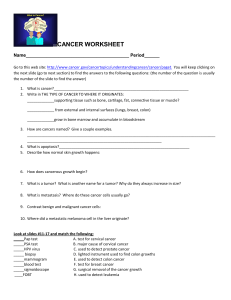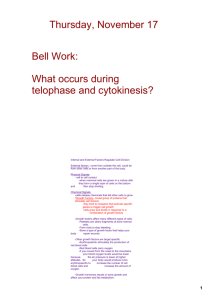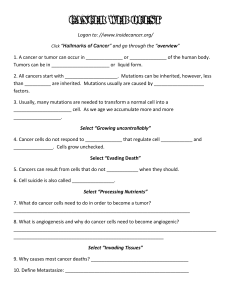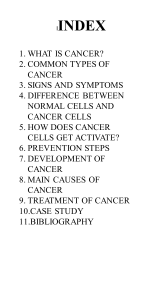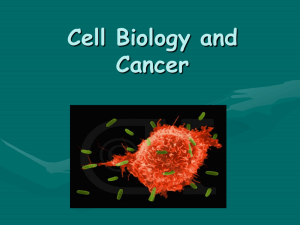Cancer Online #2 – More Details
advertisement
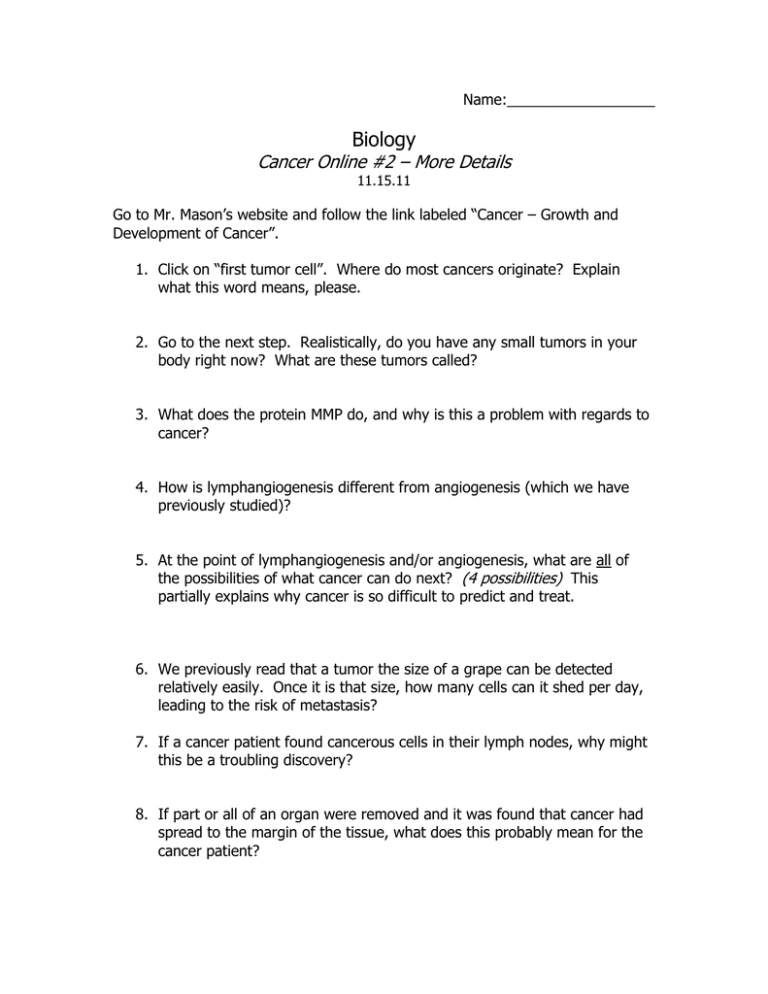
Name:__________________ Biology Cancer Online #2 – More Details 11.15.11 Go to Mr. Mason’s website and follow the link labeled “Cancer – Growth and Development of Cancer”. 1. Click on “first tumor cell”. Where do most cancers originate? Explain what this word means, please. 2. Go to the next step. Realistically, do you have any small tumors in your body right now? What are these tumors called? 3. What does the protein MMP do, and why is this a problem with regards to cancer? 4. How is lymphangiogenesis different from angiogenesis (which we have previously studied)? 5. At the point of lymphangiogenesis and/or angiogenesis, what are all of the possibilities of what cancer can do next? (4 possibilities) This partially explains why cancer is so difficult to predict and treat. 6. We previously read that a tumor the size of a grape can be detected relatively easily. Once it is that size, how many cells can it shed per day, leading to the risk of metastasis? 7. If a cancer patient found cancerous cells in their lymph nodes, why might this be a troubling discovery? 8. If part or all of an organ were removed and it was found that cancer had spread to the margin of the tissue, what does this probably mean for the cancer patient? 9. Are micro-mets harmful in and of themselves (can organs function if these metastases are present)? Explain. 10. What is it that changes this, and thus causes micro-mets to become potentially deadly macro-mets? 11. We’ve read about very large tumors in some cases, such as the tangerinesized tumor in the article from the NY Times or the grapefruit-sized one that my sister had. Tumors don’t necessarily need to be that large to cause illness or death, though, because some of our organs are quite small. Your pancreas and spleen, for example, are not large at all. That being the case, according to the site, how large does a tumor need to be to cause serious illness or death if located in a small, vitally important organ? Go back to Mr. Mason’s website and click on the link for the Inside Cancer website. 12. Under Diagnosis and Treatment, click on the pathology link. What does a pathologist do? 13. Click on #3 underneath the slides for pathology. According to Dr. De Marzo, what is it specifically about a stained (dyed) cell that can indicate if it is cancerous? 14. Click on #4 under pathology. Why does his analogy of comparing cancer cells to students make sense? Explain. 15. Click on #5, 6, and 7 and try to correctly guess which samples are from normal tissues and which are cancerous. How did you do? How could you tell which were cancerous? (I got one two out of three right, but missed one of them on my first try.) 16. The other three sections of the Diagnosis and Treatment section are important, but we don’t have time to cover all of this. If you have a family history of cancer or know a cancer patient, it is really good stuff to read. We’ll cover some of this stuff during our genetics unit next semester. For now, move on to the Pathways to Cancer link at the top. Watch the first 8 slides (it goes quickly). How is the cell signaling system related to cancer? The rest of the animations under this section are really interesting, but they’re really complex. If you have any interest in biochemistry (I know there is at least one student in my Bio class that wants to be a molecular biologist), work your way through these. It’s a good demonstration of how incredibly complex your cells are – in this case, just in order to send a message. 17. Underneath all of this, click on “Go to blog”. Click on the entry labeled “Why no cure for cancer?” (about seven entries down the page). There are two questions here, and these should be answered in paragraph form. These are not simple questions, nor are there simple answers to them. Based upon what you read, though, on the back of this page give me at least a paragraph for each of the following question: a. Why do different types of cancer have such vastly different survival rates? b. Why is there no cure for cancer, and why is the idea of a single “cure” for cancer not even a realistic idea? i. Extra Credit: Still want to learn more? Awesome! Either read through more of the blog entries and reflect on what you learn or go back to the skipped parts of the Inside Cancer website (the sections on Diagnosis and Treatment or Pathways to Cancer) and reflect on what you learn there. The amount of extra credit will depend on effort shown.


